
Original Link: https://www.anandtech.com/show/518
Introduction
You do the research
on the products. You read all the reviews. You even discuss with friends.
But even with all that information, building your own perfect personalized system
from scratch can be quite a daunting task. With that in mind, it’s no surprise
that we’ve had request after request to provide some system recommendations.
Well, today, we present the first edition of the AnandTech Buyer’s Guide, with updates coming once a month. We’ll provide some system recommendations, including a value and high-end system in 3 categories – small office / home office (SOHO), gaming, and professional. We’ve also thrown in a Dream System that represents what we would buy if money were no object.
Remember that these are just a few recommendations from us if we were building the systems. Obviously, each individual’s needs will vary greatly. But that’s the beauty of building a custom system - it can be tailored to fit those special needs.
Every component from the motherboard to the case to the monitor is covered for each system. Sample prices based on a review of popular vendors and price search engines across the web are included as well. Note that shipping is not included in these prices. An OS recommendation is included, but the price is not included in the total system price listed. Components that are not readily obtainable were automatically out of the running for any system in the Buyer’s Guide. Where possible, we’ll link to reviews of the individual products on AnandTech for more in depth information.
So without further ado, let’s get started…
Dream System
Not having to
worry about price is a luxury few people have, but it never hurts to dream up
what you would buy in such a situation. Or maybe you’ve just won the lottery.
Perhaps it’s not even your own money involved thanks to a grant or simply an
ungodly budget. Whether dreaming or actually looking to buy, putting together
the dream professional system can be a tricky, but fun, proposition. Below are
our picks for such a system.
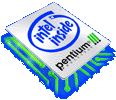 CPU
– Dual Pentium III 733 - $600 each
CPU
– Dual Pentium III 733 - $600 each
The CPU is probably
the most critical, as well as the most controversial, component of any system.
The old AMD versus Intel battle wages on stronger than ever before with the
Athlon and Pentium III. It’s a touchy subject among many die-hard fans of each
processor type, but for the professional dream system, we have to go with an
Intel CPU for one key reason – SMP. While the benefits of SMP vary greatly
depending on the applications in use, professional apps are generally the ones
best able to take advantage of SMP. Recently, games have begun to take some
advantage of SMP, starting with Quake 3: Arena. Now that Windows 2000 supports
SMP and DirectX7, we should begin seeing more games that are capable of using
SMP.
While Pentium III’s up to 1GHz have already been announced by Intel, don’t even waste your time trying to get a hold of one at this point. Even if they were available, Intel has actually not qualified the 1 GHz Pentium III for SMP operation according to their own site. We also decided to pass on the new Pentium III Xeon’s since the only difference between them and the standard model is the Slot-2 interface that it uses and the higher price.
The fastest readily available Pentium III is the 733 MHz model, so that’s what we’re going with. They’re currently available for just under $500 in quantities of 1000 from Intel. Unfortunately, a quick look around the web shows that Intel’s supply problems are driving up the prices here too – we saw some vendors in the lower $500, but expect to pay closer to $600 for one.
For more information on all Pentium III's, read our Pentium III 1GHz Review.
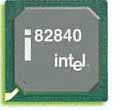 Motherboard
– Intel OR840 - $400
Motherboard
– Intel OR840 - $400
Our choice of
dual Pentium III’s narrowed down our motherboard options very quickly. The i440BX,
i820, and i840 are the primary SMP chipsets available right now. Tyan has already
announced the Tiger 133, a dual Slot-1 board based on the VIA Apollo Pro 133A
chipset. Since it’s not available yet, it is immediately out of the running
here.
We wanted to take full advantage of the 133 MHz FSB speed of our CPU, as well as AGP 4X and Intel’s Accelerated Hub Architecture (AHA). That of course meant either the i820 or the i840. Since cost is not an object on this system, the choice was simple – the i840 since it offers the advantage of dual RAMBUS channels, which provide a total of 3.2GB/s of bandwidth. Without the cost factor holding us back, our dream system is equipped with RDRAM as well.
Of all the i840 boards out there, the OR840 from Intel is the only one that fits our requirements and is currently available. It also throws in an optional onboard Intel 82559 ethernet controller and an AGP Pro 50 slot. There is also optional AC97 audio onboard, which may be sufficient if you don’t really use sound that much in your work. But why cripple a system like this with host-based audio? We’ll disable it and add a true hardware based PCI card later.
Unfortunately, the OR840 choice means overclocking is out for now. As more i840 boards become available, we’ll revise the motherboard selection with something that will allow us to push our CPU’s.
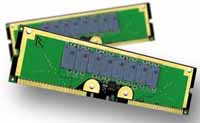 Memory
– 512MB PC800 RDRAM (4x128MB RIMM’s) - $4000
Memory
– 512MB PC800 RDRAM (4x128MB RIMM’s) - $4000
Not having to
worry about cost is a beautiful thing and really comes in handy when choosing
a memory type, especially since you can easily spend more on memory than most
people spend on their whole system. As such, we had no hesitation in picking
RDRAM for our dream system even though they cost $1000 for a 128MB stick. Since
we’ve got two RAMBUS channels on our OR840 motherboard, we need to install our
RIMM’s in pairs. Even without that requirement, what dream professional system
would be complete with 512MB of RAM total? Since the largest RIMM readily available
on the market today is 128MB, we need 4 sticks in order to get a total of 512MB
RAM.
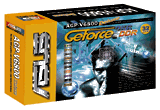 Video
card – ASUS V6800 Deluxe - $330
Video
card – ASUS V6800 Deluxe - $330
The GeForce DDR
is clearly the leading 3D graphics chipset at the moment. Not only does the
GeForce offer the only fully functional GPU in the market right now, but it
also has the highest fillrate at 480 megapixels/s. DDR SDRAM insures that you’ll
be able to reap the full benefits of the GeForce at higher resolutions and color
depths – how does 60fps gaming at 1024x768 in 32-bit color sound?
The ASUS V6800 Deluxe was also able to stand out from the crowd in our recent DDR GeForce roundup with its video capture and hardware monitoring capabilities. The video capture options speak for themselves, but the hardware monitoring enables ASUS’s Smart Doctor Utility to dynamically overclock your card, while monitoring its temperature to prevent any issues that can come with overclocking a device too far.
Being based on the NVIDIA GeForce chipset means the V6800 inherits excellent driver support under all the major OS’s. If you’re looking for a dream professional system, just drop in an ELSA GLoria II, which is based on the Quadro. The GLoria II is merely an SDR SDRAM card, and that’s the reason it doesn’t get the overall recommendation.
For more information on the ASUS V6800 Deluxe, read our DDR GeForce Roundup and our ASUS V6800 Deluxe Review.
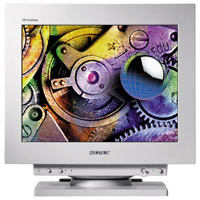 Monitor
– Sony GDM-F500R - $2000
Monitor
– Sony GDM-F500R - $2000
This pure flat
monitor is without a doubt the best monitor we’ve ever set our eyes on. The
FD Trinitron tube insures the screen is completely flat, but what makes the
GDM-F500R so special is the 0.22mm stripe pitch across the whole screen. Support
for resolutions up to 2048 x 1536 @ 75Hz rounds out the package. You’ve got
to see it to believe it – one look and you’ll be hooked. But at $2000, it remains
just a dream for the vast majority of us.
Case – Addtronics W8500-400A
- $400
We took a look
at the Addtronics W8500 not too long ago. For those that don’t remember, it’s
a WTX case, meaning that it’s backwards compatible with today’s ATX standard
and will also accept future boards based on the WTX standard. A grand total
of 9 fan locations ensure that you’ll always have plenty of cooling available,
while 11 drive bays handle expansion. To ensure that we have enough power,
we’ll go with the 400W power supply option from Addtronics – that should be
plenty for just about anything we could throw at it.
For more information, read our Addtronics W8500 Review.
 Sound
Card – Sound Blaster Live! Platinum - $200
Sound
Card – Sound Blaster Live! Platinum - $200
The sound card
selection for the dream professional system was as tricky as any other component.
But some careful thought shows that the Sound Blaster Live! is the best choice.
The first problem is that a number of sound cards out there don’t have drivers
that work properly with SMP systems under NT 4.0. Further, the ideal sound
card would also have driver support under Windows 2000, Linux, and BeOS.
The Aureal Vortex 2 cards come close, but they currently have no BeOS support and, more importantly, don’t work reliably with SMP under NT 4.0. The Sound Blaster Live! provides all the features we need in a sound card and thus it is the only choice for this system. It’s got full support under Windows NT 4.0 and is one of the first cards with a feature complete driver set under Windows 2000 with the recent release of Live!Ware for Win2000. Creative also has their own set of Linux drivers, while BeOS has built in support for the Live!
Specifically, we chose the Platinum model since we don’t have to worry about price and, besides, the Live Drive of the Platinum is a nice addition to any system.
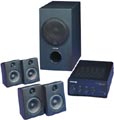 Speakers
– VideoLogic Sirocco CrossFire - $400
Speakers
– VideoLogic Sirocco CrossFire - $400
As the best speaker
set we’ve tested to date, it’s no surprise the VideoLogic Sirocco CrossFire
ended up in our dream system. Although it “only” has 80W of power, the Crossfire
makes up for it elsewhere. Just like in the home audio market, more power doesn’t
necessarily translate to higher fidelity audio.
For more information, read our Video Logic Sirocco CrossFire Review.
Ethernet – integrated
Intel 82559 on motherboard – “free”
Since our motherboard
choice, the OR840 already has an integrated Intel 82559 chip onboard, there’s
no reason to go with anything else. It’s an excellent 10/100 fast ethernet
chipset, used in Intel’s Pro/100+ Management adapter for the desktop, and is
supported fully under Linux and Windows 2000. Even if it weren't on the motherboard,
we'd probably be picking the Pro/100+ Management adapter in its place anyway.
Hard Drive – Seagate
Cheetah 73 - $1600
![]() Hard
drive performance has always been one of the biggest bottlenecks in the speed
of a computer. After all, the only component whose speed is measured in milliseconds
is the hard drive – everything else is nanoseconds or microseconds. But at
10,000 rpm the Seagate Cheetah series has always led the market in performance.
The new Cheetah 73 moves to even higher density platters for increased capacity
and speed. With 73GB of space, it should satisfy all but the most storage intensive
tasks, while the Ultra 160 interface provides a maximum throughput of 160MB/s
to keep things moving along smoothly.
Hard
drive performance has always been one of the biggest bottlenecks in the speed
of a computer. After all, the only component whose speed is measured in milliseconds
is the hard drive – everything else is nanoseconds or microseconds. But at
10,000 rpm the Seagate Cheetah series has always led the market in performance.
The new Cheetah 73 moves to even higher density platters for increased capacity
and speed. With 73GB of space, it should satisfy all but the most storage intensive
tasks, while the Ultra 160 interface provides a maximum throughput of 160MB/s
to keep things moving along smoothly.
SCSI Adapter – Adaptec
29160 - $275
The first name
that pops to mind for SCSI adapters is, of course, Adaptec. Their Ultra160
adapter is the 29160 and is one of the first on the market. Its 64-bit interface
could come in handy down the line, but our OR840 motherboard doesn’t have any
64-bit PCI slots. Rest assured, it will work in a standard 32-bit PCI slot
as well.
CD-ROM/CD-R(W)/DVD-ROM
Pioneer DVD-303S
/ Plextor UltraPlex Wide - $140
Plextor Plexwriter 12/4/32 - $350
This one is a
matter of personal preference, but the top two options are the Pioneer 6X SCSI
DVD-ROM, which is also capable of reading CD’s at 32X max, and the Plextor Ultra
Plex 40X max UW SCSI CD-ROM. Plextor drives are well known for their reliability
and excellent performance, although Pioneer is certainly no slouch. If you
want DVD support, go with the Pioneer. Otherwise, stick with the Plextor.
Note, we passed on the 10X DVD from Pioneer in the interest of keeping our system all SCSI.
Plextor can’t be denied in the CD-RW category as they have one of the few 12X burners on the market. The Plextor name is synonymous with reliability and high performance and the Plexwriter 12/4/32 delivers on all accounts. It’s a SCSI model, but that’s not a problem since we already have a SCSI adapter in the system for the HD.
Operating System – Quadruple
boot:
Windows 2000 Professional OR Windows NT 4.0 Workstation - $250
Windows 98SE – $150
Your favorite Linux distribution – free download or $50 retail
BeOS Version 4.5 - $70 (version 5.0 will be free for download starting March
28, 2000)
This is another matter of preference, and is obviously affected by your particular application requirements. However, since we’ve gone with an SMP system, we at least need an SMP capable OS, and all of the above take advantage of SMP except for Windows 98. We’ll quadruple boot between the OS’s depending on what we need to do.
 Windows
2000 Professional is probably the best bet if you have the future in mind.
Its enhanced hardware support, including full USB and IEEE1394 (Firewire), will
be the key to its success and the reason it’s our pick over NT 4.0. Windows
NT 4.0 is a more tried and true solution; so if that is of concern to you, by
all means go with NT 4.0.
Windows
2000 Professional is probably the best bet if you have the future in mind.
Its enhanced hardware support, including full USB and IEEE1394 (Firewire), will
be the key to its success and the reason it’s our pick over NT 4.0. Windows
NT 4.0 is a more tried and true solution; so if that is of concern to you, by
all means go with NT 4.0.
Just about any current Linux distribution should support SMP right out of the box. If not, go with the tried and true Redhat 6.1 – we know for sure it supports SMP without any additional installation steps. The beauty of Linux? It’s free if you’re willing to download a distribution from the internet. This is getting easier and easier now that you can just download a bootable ISO CD image that you can burn. If that’s too much work, but you still want it cheap, there are a number of companies on the net that will sell you the GPL (same as the download) version of your favorite distribution for under $5. If you want a full manual and support, go for a retail distribution, like the boxed Redhat set that sells for about $50.
 The
last major SMP-aware OS is BeOS, an OS that hasn’t been around nearly as long
as any of the others. We think that this OS is cool enough to be worth its
price of admission, only $70. Of course, version 5.0 will be released on the
web for free on March 28, 2000, so you should definitely give it a shot then.
The
last major SMP-aware OS is BeOS, an OS that hasn’t been around nearly as long
as any of the others. We think that this OS is cool enough to be worth its
price of admission, only $70. Of course, version 5.0 will be released on the
web for free on March 28, 2000, so you should definitely give it a shot then.
Of course, the option of booting to Windows 98 is still there if you need to play games, but remember that it doesn’t support SMP. Windows 2000 users won’t absolutely have to do this as 2000 has full DirectX 7 support built in, although it does take a performance hit in games as compared to Win98.
High-end SOHO
The small office/home office machine has a unique set of requirements. It
must provide quick and snappy 2D performance, be very stable. The keys to good
performance on such a machine is lots of RAM and a fast hard drive.
 Processor
– AMD Athlon 650 - $200
Processor
– AMD Athlon 650 - $200
Although CPU performance
isn’t the most important factor for many office applications, there are some
where CPU performance is critical. At similar clock speeds, the Athlon holds
a significant advantage in price, and for that reason, we’ve chosen an Athlon
650. Throw in a Golden Fingers device and the 650 can easily overclock to somewhere
between 700 and 800 MHz.
For more information on all Athlon processors, read our Athlon 1GHz Review.
Motherboard – EPoX EP-7KXA
- $140
If you’re going
with an Athlon CPU, the VIA KX133 chipset is clearly the best platform to run
it on. Unfortunately, there’s a lack of good KX133 boards that are also widely
available and that has driven price up considerably through good old supply
and demand. The EPoX is the only widely available KX133, so it’s our pick for
now, but better KX133 boards are on the way.
For more information, read our EPoX EP-7KXA Review.
Memory – 256MB Corsair
or Mushkin PC133 SDRAM (2x128MB DIMM’s) – $250
Even though memory
is relatively cheap these days, 256MB is more than enough. We could have dropped
down to 128MB, but the savings didn’t justify the performance loss. Besides,
this is our high-end SOHO machine, and there’s room in the budget.
As for the exact brand of memory, we recommend Corsair or Mushkin modules. We use them in our test systems and have had absolutely no problems with them.
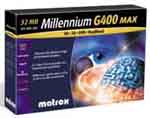 Video
card – Matrox G400 32MB Dual Head - $180
Video
card – Matrox G400 32MB Dual Head - $180
We’ve always found
Matrox cards to do an excellent job in business environments, and their latest
card, the G400, is no exception. You’ll get snappy 2D display, DVD playback,
and excellent display driver utilities that include useful features like virtual
desktop. With the option for dual head, you can add a second monitor to potentially
double your workspace. And if you need to take a break from work, the G400
is ready to frag away ;)
For more information, read our Matrox G400 & G400 MAX Review.
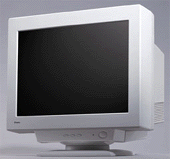 Monitor
– iiYama VisionMaster PRO 450 - $650
Monitor
– iiYama VisionMaster PRO 450 - $650
If you’re going
to be sitting in front of your monitor for hours a day, it’s critical that you
have a crisp monitor that can provide a flicker-free refresh rate at your resolution
of choice. Using a Mitsubishi Diamondtron NF, the iiYama VisionMaster Pro 450
provides a perfectly flat display surface using the same technology in Sony’s
FD Trinitron models, but at a lower cost. The VisionMaster PRO 450 is a 19”
monitor and has been highly acclaimed here on AnandTech and by owners alike.
If you’ve got the funds, we highly recommend you go with the 22” VisionMaster
PRO 510 for about $1000.
For more information, read our iiYama VisionMaster PRO 450 and VisionMaster PRO 510 Reviews.
Case – Supermicro SC750-A
Full Tower ATX - $150
We need a case
that can handle anything we can throw at it, but at a reasonable price level.
That case is the Supermicro SC750-A full tower and is available for about $150
with an Athlon approved 300W Sparkle power supply. A total of ten drive bays
and the ability to accept an extended ATX motherboard insures that this system
will always have room for upgrades.
For more information, read our Supermicro SC750-A Review.
 Sound
card – Sound Blaster Live! Value OEM - $50
Sound
card – Sound Blaster Live! Value OEM - $50
The choice here
is simple – SBLive!, since Creative is the only manufacturer offering complete
driver support under Windows 2000. If you want to save a bit more money, go
with any name brand card supported under Windows 2000.
Speakers – Cambridge
SoundWorks Digital - $100
The SoundWorks
Digital is a 2.1 system that features the same drivers and sub as the highly
acclaimed Desktop Theater DTT2500. Need we say more?
For more information, read our Cambridge SoundWorks Desktop Theater DTT2500 Review.
Ethernet – Linksys EtherFast
10/100 - $20
We use Linksys
products here in the AnandTech lab all the time and have never been disappointed.
Besides, at just $20 for a card with full support directly from the manufacturer
under the major OS’s, including Linux and Windows 2000, the EtherFast 10/100
is a deal that’s impossible to pass up.
 Hard
drive – Maxtor Diamond Max 40 Plus 40GB - $300
Hard
drive – Maxtor Diamond Max 40 Plus 40GB - $300
We couldn’t get
a hold of one in time for our March 2000 Ultra ATA 66 Roundup, but the Diamond
Max 40 Plus is on the way to the lab now. Based on user feedback and reviews
around the web, this is clearly the fastest Ultra ATA 66 hard drive for now.
“For now” being the operative words, however, as the hard drive industry is
moving faster than ever before. For now, our high-end professional machine
will use the 40GB model from the Diamond Max 40 Plus family.
If your work is disk intensive, considering going with a 10,000 RPM drive and an Ultra 160 controller. The Atlas 10K II is widely available and is well known to be one of the fastest drives available.
CD-ROM/CD-RW/DVD-ROM
Pioneer DVD-104S 10X Slot DVD - $140
Plextor Plexwriter 8/4/32 - $350
What high-end
system is complete today without a DVD-ROM? We decided to go with the Pioneer
DVD-104S, a 10X DVD-ROM drive with a slot-loading interface that is just too
slick. Of course, it also reads CDs as well at a swift 40X max clip.
If you don’t need DVD support, the Kenwood TrueX 72X will provide you with the fastest CD-ROM speed at a slightly lower cost of $120.
Plextor is back again, this time with the fastest IDE CD-R on the market right now. The PlexWriter 8/4/32 is their first entry into the IDE market, and it has been selling like hot cakes since its release.
 OS
– Windows 2000 - $250
OS
– Windows 2000 - $250
You want to get
work done, right? Well, you definitely don’t want your system crashing and
destroying unsaved work all the time. Windows 2000 is the only way to go for
rock solid stability. If you don’t need all the features of Windows 2000, but
want a more tried and true solution, drop back to Windows NT 4.0, but note that
you’ll lose access to the vast array of USB peripherals out there.
Value SOHO
The Value SOHO machine is much like the high-end model, but toned down a
bit. We still need a fast hard drive and lots of RAM above all else.
 Processor
– Intel Celeron 466 - $85
Processor
– Intel Celeron 466 - $85
The Celeron makes
the perfect choice for our value SOHO machine– it’s cheap, but you still get
a relatively fast processor for the applications this machine will be used for.
The cheapest Celeron that’s widely available today is the 400 MHz model, which
runs about $80. However, for just five dollars more, you can get a 466 and
the accompanying 17% performance increase for CPU intensive work.
For more information on all Celeron processors, read our Celeron 533 Review.
Motherboard – AOpen MX3W
- $90
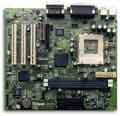 As
long as gaming performance isn’t involved, the i810 offers more than sufficient
power for a basic home system. Boards with the i810E currently cost about $50
more than comparable i810 boards, and we don’t need the 133 MHz FSB speed for
our 66 MHz FSB Celeron.
As
long as gaming performance isn’t involved, the i810 offers more than sufficient
power for a basic home system. Boards with the i810E currently cost about $50
more than comparable i810 boards, and we don’t need the 133 MHz FSB speed for
our 66 MHz FSB Celeron.
Since this will be a work machine, quite possibly the most important factor in a motherboard is stability, and the AOpen MX3W was one of the most stable i810 boards we’ve tested. It’s easy to find and costs under $90, making it a good choice for our system. It is, however, a microATX board, so if you need a lot of expansion, look for something in a full ATX form factor.
For more information, read our AOpen MX3W Review.
Memory – 128MB Mushkin
or Corsair PC133 SDRAM - $125
Never underestimate
the value of RAM – it needs to be high quality, high speed, and most importantly,
you need lots of it. Not too long ago, 64MB seemed like a ton, but with prices
so low today, 128MB is the real minimum you should accept.
As for the exact brand of memory, we recommend Corsair or Mushkin modules. We use them in our test systems and have had absolutely no problems with them.
Video card – Integrated
i810 Video – “free”
Although the integrated
video on the i810 is not incredibly fast, it is more than sufficient to power
basic Windows 2D applications.
For more information, see our i810 Chipset Review.
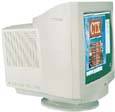 Monitor
– CTX VL950SL - $350
Monitor
– CTX VL950SL - $350
Monitors are one
of the few computer components that you can usually hang onto for years to come.
With that in mind, we didn’t want to go with anything smaller than a 19” on
our value SOHO system – besides, once you’ve worked on a monitor this big, there’s
no going back.
The best deal we could find on a 19” monitor was the CTX VL950SL, which will run you about $350. It’s a shortneck model that uses the same 0.26 mm dot pitch tube that many of the bigger brands use.
 Case
– Fong Kai FK-603 - $60
Case
– Fong Kai FK-603 - $60
We loved the Fong
Kai FK-603 when we first tested it, and it’s the perfect case for our value
systems. It’s only $60, but has plenty of space for everything in our system.
What makes it the clear choice is the ease of access to the interior and excellent
cooling for a case this size. Although not critical for this system since it
uses a Celeron, it also features an AMD approved power supply.
You could also go with a microATX case to save a bit more money, but the price differential isn’t worth being locked into such limited expansion.
For more information, read our Fong Kai FK-603 Review.
Sound card – Integrated
AC97 Audio – “free”
The host-based
AC97 CODEC will get you by for basic sound needs, but it eats up precious CPU
resources when in use. If you really need to keep the cost as low as possible,
stick with this, but otherwise get a “real” hardware PCI sound card, even if
you just want to play MP3’s.
For more information, see our i810 Chipset Review.
Speakers – Generic - $20
The AC97 CODEC
isn’t of the highest quality either, so there’s no need to go with a hi-fi speaker
set here. We just need something to get us by for basic Windows sounds, so
just go down to any local store and see what you can find for $20.
Ethernet – Linksys EtherFast
10/100 - $20
We use Linksys
products here in the AnandTech lab all the time and have never been disappointed.
Besides, at just $20 for a card with full support directly from the manufacturer
under the major OS’s, including Linux and Windows 2000, the EtherFast 10/100
is a deal that’s impossible to pass up.
 Hard
drive – Maxtor Diamond Max 40 Plus 15GB - $160
Hard
drive – Maxtor Diamond Max 40 Plus 15GB - $160
We still maintain
that hard drive speed is one of the biggest bottlenecks in a system, so we won’t
skimp in this category. As such, we’ve simply chosen a smaller version of the
drive in our high-end system, the 15GB Maxtor Diamond Max 40 Plus. It provides
the same speed as the 40GB model, but with less storage space.
If you simply need more space, you can either drop down to a 5400rpm drive or pay a bit more for a larger 7200rpm model.
CD-ROM/CD-RW/DVD-ROM
- Name brand 40X – 50X CD-ROM - $40
While many will
suggest going with the cheapest CD-ROM you can find, we highly recommend going
with a name brand, not just the cheapest generic. Our experience with the no-names
is that many of them do not perform as advertised, and even have trouble reading
less than perfect discs. Acer, Creative Labs, Toshiba, and Teac all do an excellent
job.
 OS
– Windows 2000 - $250
OS
– Windows 2000 - $250
You want to get
work done, right? Well you definitely don’t want your system crashing and destroying
unsaved work all the time. Windows 2000 is the only way to go for rock solid
stability. If you don’t need all the features of Windows 2000, but want a more
tried and true solution, drop back to Windows NT 4.0 but note that you’ll lose
access to USB peripherals, which many of the cheap scanners out there use.
High-end Gaming System
The purpose of
this system is simple – maximum frame rates at all costs. Of course, we already
have a “cost is no object” dream system, so we’ve decided to shoot for a price
in the $3500 range on the high-end gaming system. That price is without floppy,
keyboard, mouse, or software. Even though it’s not in the price, we will recommend
an OS configuration.
 Processor
– Intel Pentium III 733 - $600
Processor
– Intel Pentium III 733 - $600
We choose the
Pentium III 733 again for our second dream system. Our benchmarks have shown
that the Pentium III 733 outpaces the comparably priced Athlon 800 in Quake
3 and Unreal Tournament. The Athlon 800 takes a slight lead in Expendable,
but needs the clock speed advantage to do so. That 2/5 speed cache of the Athlon
holds it back – when Thunderbird arrives, the tables could very easily turn.
Overclockers can’t hope to push their 733’s to over 800 MHz without resorting to exotic cooling. While overclocking is not guaranteed, we’ve had good results with the Coppermine CPU’s.
For more information on all Pentium III's, read our Pentium III 1GHz Review.
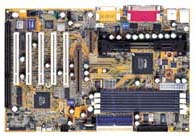 Motherboard
– Gigabyte GA-6VX-4X - $120
Motherboard
– Gigabyte GA-6VX-4X - $120
Since we’ve got
a Pentium III 733, we need a motherboard with official 133 MHz FSB support.
We can strike the i440BX due to its lack of official 133 MHz FSB. The i810 is
obviously out of the question thanks to its slow integrated video. Intel’s
i820 is out due to the incredibly high cost of RDRAM and its horrendous performance
with SDRAM.
Intel’s i815 on the horizon looks promising – it has support for PC133 SDRAM, official 133 MHz FSB, AGP 4X, Ultra ATA 66, and Intel’s Accelerated Hub Architecture (AHA). But it is unlikely that we will see the i815 until June of this year at the earliest.
That leaves us with one clear choice – the VIA Apollo Pro 133A with it’s AGP 4X, Ultra ATA 66, and official 133 MHz FSB support. After our recent roundup, we found the 6VX-4X to be the best overall VIA 133A board. We mentioned it in the review, but for now, we can’t offer a solid recommendation of the ASUS P3V4X due to its performance issues with the latest AGP GART drivers. You can get by with an older version, but we don’t consider that an ideal solution by any means. Read the full review for details. As it stands, we’ll stick with the Gigabyte 6VX-4X, which is also a very solid board.
Once again, AC97 support is included onboard, with the option for integrated Aureal 8810 hardware sound. However, we’ll disable the host-based sound and pass on the Aureal 8810 in favor of choosing our own sound card later.
For more information, read our Gigabyte GA-6VX-4X Review.
Memory – 256MB Corsair
or Mushkin PC133 SDRAM (2x128MB DIMM’s) – $250
Even though memory
is relatively cheap these days, 256MB is more than enough. We could have dropped
down to 128MB, but the savings didn’t justify the performance. In any case,
as this is our high-end gaming machine, there’s room to move in the budget.
As for the exact brand of memory, we recommend Corsair or Mushkin modules. We use them in our test systems and have had absolutely no problems with them.
 Video
card – ASUS V6800 Deluxe - $330
Video
card – ASUS V6800 Deluxe - $330
The GeForce DDR
is clearly the leading 3D graphics chipset at the moment. Not only does the
GeForce offer the only fully functional GPU in the market right now, but it
also has the highest fillrate at 480 megapixels/s. DDR SDRAM insures that you’ll
be able to reap the full benefits of the GeForce at higher resolutions and color
depths – how does 60fps gaming at 1024x768 in 32-bit color sound?
The ASUS V6800 Deluxe was also able to stand out from the crowd in our recent roundup with its video capture and hardware monitoring capabilities. The video capture options speak for themselves, but the hardware monitoring enables ASUS’s Smart Doctor Utility to dynamically overclock your card, while monitoring its temperature to prevent any issues that can come with overclocking a device too far.
For more information on the ASUS V6800 Deluxe, read our DDR GeForce Roundup and our ASUS V6800 Deluxe Review.
 Monitor
– iiYama VisionMaster PRO 450 - $650
Monitor
– iiYama VisionMaster PRO 450 - $650
Using a Mitsubishi
Diamondtron NF, the iiYama VisionMaster Pro 450 provides a perfectly flat display
surface using the same technology in Sony’s FD Trinitron models, but at a lower
cost. The VisionMaster PRO 450 is a 19” monitor and has been highly acclaimed
here on AnandTech and by owners alike. If you’ve got the funds, we highly recommend
you go with the 22” VisionMaster PRO 510 for about $1000.
For more information, read our iiYama VisionMaster PRO 450 and VisionMaster PRO 510 Reviews.
Case – Supermicro SC750-A
Full Tower ATX - $150
We need a case
that can handle anything we can throw at it, but at a reasonable price level.
That case is the Supermicro SC750-A full tower and is available for about $150
with a 300W Sparkle power supply. A total of ten drive bays and the ability
to accept an extended ATX motherboard insures that this system will always have
room for upgrades.
For more information, read our Supermicro SC750-A Review.
 Sound
card – Sound Blaster Live! X-Gamer - $100
Sound
card – Sound Blaster Live! X-Gamer - $100
Choosing between
the Aureal SQ2500 and the SBLive! was one of the more difficult decisions in
this guide. With the dream system, we needed an SMP compatible card, and the
Live! was the one that fit the bill, but we don’t have that requirement here.
We’ve decided to stick with the Sound Blaster Live! anyway for its ability to
connect digitally to a four point surround system. Throw in proper support
for Windows 2000 and the SBLive! is hard to pass by. We chose the X-Gamer model
for its digital speaker interface, although you can save about $50 by going
with an OEM model.
If you don’t plan on using the digital speaker interface, the Aureal SQ2500 is a better choice since it supports both EAX and A3D in the latest driver release. Basic audio support is included with Windows 2000 and a beta of the feature complete Aureal drivers have been leaked around the internet, so we should see something official soon. An OEM version of the SQ2500 is also available for around $50 with a bit of searching.
 Speakers
– Cambridge SoundWorks Desktop Theater DTT2500 - $200
Speakers
– Cambridge SoundWorks Desktop Theater DTT2500 - $200
We obviously need
some speakers with 4-channel surround support to properly render the 3D positional
audio output of our SBLive! As mentioned previously, we also wanted something
that could interface with the digital out on the Live! Well, the Desktop Theater
DTT2500 looked to fit the bill. But the real key is its top-notch sound quality
and built-in Dolby Digital decoder.
For more information, read our Cambridge SoundWorks Desktop Theater DTT2500 Review.
Ethernet – Linksys EtherFast
10/100 - $20
We use Linksys
products here in the AnandTech lab all the time and have never been disappointed.
Besides, at just $20 for a card with full support directly from the manufacturer
under the major OS’s, including Linux and Windows 2000, the EtherFast 10/100
is a deal that’s impossible to pass up.
 Hard
drive – Maxtor Diamond Max 40 Plus 40GB - $300
Hard
drive – Maxtor Diamond Max 40 Plus 40GB - $300
We couldn’t get
a hold of one in time for our March 2000 Ultra ATA 66 Roundup, but the Diamond
Max 40 Plus is on the way to the lab now. Based on user feedback and reviews
around the web, this is clearly the fastest Ultra ATA 66 hard drive for now.
“For now” being the operative words, however, as the hard drive industry is
moving faster than ever before. Until something else passes this drive by,
our high-end gaming machine will use the 40GB model from the Diamond Max 40
Plus family.
CD-ROM/CD-RW/DVD-ROM
Pioneer DVD-104S 10X Slot DVD - $140
Plextor PlexWriter
8/4/32 - $200
What high-end
system is complete today without a DVD-ROM? We decided to go with the Pioneer
DVD-104S, a 10X DVD-ROM drive with a slot-loading interface that is just too
slick. Of course, it also reads CDs as well at a swift 40X max clip.
If you don’t need DVD support, the Kenwood TrueX 72X will provide you with the fastest CD-ROM speed on earth at a slightly lower cost of $120.
Plextor is back again, this time with the fastest IDE CD-R on the market right now. The PlexWriter 8/4/32 is their first entry into the IDE market, and it has been selling like hot cakes since its release.
 OS
– Windows 2000 / Windows 98SE Dual Boot - $400 for both
OS
– Windows 2000 / Windows 98SE Dual Boot - $400 for both
Even though Windows
2000 supports DirectX 7, immature drivers and the general overhead of the OS
prevent it from performing on par with Windows 98 when it comes to games. Of
course, Windows 2000 is the future, and its just so much more stable. Our solution:
work in Windows 2000 and boot back to Windows 98SE if you need maximum performance
for games. Of course, if you just need a quick break from work, you can still
frag in Win2K.
Value Gaming
Once again, the value machine
has the same goals as the high-end, but this time we're focused on gaming performance.
Lots of RAM is again an important factor, but 3D acceleration and CPU performance
are now also critical.
 Processor
– AMD Athlon 650 - $250
Processor
– AMD Athlon 650 - $250
Although it’s
a bit slower in games, the Athlon holds a significant advantage in price at
similar clock speeds, and for that reason, we’ve chosen an Athlon 650 for our
value gaming system. Throw in a Golden Fingers device and the 650 can easily
overclock to somewhere between 700 and 800 MHz.
For more information on all Athlon processors, read our Athlon 1GHz Review.
Motherboard – EPoX EP-7KXA
- $140
If you’re going
with an Athlon CPU, the VIA KX133 chipset is clearly the best platform to run
it on. Unfortunately, there’s a lack of good KX133 boards that are also widely
available and that has driven price up considerably through good old supply
and demand. The EPoX is the only widely available KX133, so it’s our pick for
now, but better KX133 boards are on the way.
For more information, read our EPoX EP-7KXA Review.
Memory – 128MB Mushkin
or Corsair PC133 SDRAM - $125
Never underestimate
the value of RAM – it needs to be high quality, high speed, and most importantly,
you need lots of it. Not too long ago, 64MB seemed like the maximum amount
that you would need, but with prices so low today, 128MB is the real minimum
you should accept.
As for the exact brand of memory, we recommend Corsair or Mushkin modules. We use them in our test systems and have had absolutely no problems with them.
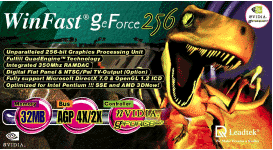 Video
card – Leadtek GeForce 256 DDR Rev. B. - $270
Video
card – Leadtek GeForce 256 DDR Rev. B. - $270
Even for our value
system, we have to go with a GeForce DDR – it’s only about $70 more than an
SDR card and the difference in performance at higher resolutions is just too
much to pass up.
While the performance of all GeForce DDR cards is within a few percentage points of each other, the Leadtek GeForce 256 DDR Revision B was able to out distance the other cards in our recent roundup in other areas, namely its excellent cooling without a significant increase in price. Thanks to that cooling, we were able to push our evaluation sample up to 160 MHz core clock – the fastest of any GeForce we’ve tested to date.
If you’re not overclocking, just go with the best deal on a GeForce DDR that you can find – they’re all clocked the same and thus perform within a few percent of each other.
For more information, read our GeForce DDR Roundup and our Leadtek GeForce 256 DDR Rev. B Review.
 Monitor
– CTX VL950SL - $350
Monitor
– CTX VL950SL - $350
Monitors are one
of the few computer components that you can usually hang onto for years to come.
With that in mind, we didn’t want to go with anything smaller than a 19” on
our value gaming system – besides, once you’ve gamed on a monitor this big,
there’s no going back.
The best deal we could find on a 19” monitor was the CTX VL950SL, which will run you about $350. It’s a shortneck model that uses the same 0.26 mm dot pitch tube that many of the bigger brands use.
 Case
– Fong Kai FK-603 - $60
Case
– Fong Kai FK-603 - $60
We loved the Fong
Kai FK-603 when we first tested it and it’s the perfect case for our value systems.
It’s only $60, but has plenty of space for everything in our system. What makes
it the clear choice is the ease of access to the interior, excellent cooling
for a case this size, and, most importantly, an AMD approved power supply.
For more information, read our Fong Kai FK-603 Review.
Sound card – Sound Blaster
Live! Value OEM / Aureal SQ 2500 OEM Vortex2- $50
There’s nothing
that makes the Live! or Vortex2 stand out ahead of the other to make the sound
card choice for the value gaming system cut and dry. A slight edge goes the
SQ2500 since Aureal’s latest Vortex2 reference drivers include support for EAX,
allowing it to work with both A3D 2.0 and EAX 1.0 games.
Speakers - Cambridge
Sound Works PCWorks Four Point Surround / Altec Lansing ACS54 - $70
We still want
a good set of four channel speakers for our value gaming system, and both the
Cambridge PCWorks FPS and the Altec ACS54 fit our requirements while maintaining
a relatively low price of $70. If you don’t care about 4-channel surround,
there are a number of speaker systems that will provide higher quality, but
just stereo, sound at a similar price point.
Ethernet – Linksys EtherFast
10/100 - $20
We use Linksys
products here in the AnandTech lab all the time and have never been disappointed.
Besides, at just $20 for a card with full support directly from the manufacturer
under the major OS’s, including Linux and Windows 2000, the EtherFast 10/100
is a deal that’s impossible to pass up.
 Hard
drive – Maxtor Diamond Max 40 Plus 15GB - $160
Hard
drive – Maxtor Diamond Max 40 Plus 15GB - $160
We still maintain
that hard drive speed is one of the biggest bottlenecks in a system, so we won’t
skimp in this category. As such, we’ve simply chosen a smaller version of the
drive in our high-end system, the 15GB Maxtor Diamond Max 40 Plus. It provides
the same speed as the 40GB model, but with less storage space.
If you simply need more space, you can either drop down to a 5400rpm drive or pay a bit more for a larger 7200rpm model.
CD-ROM/CD-RW/DVD-ROM
– Name brand 40X – 50X CD-ROM - $40
While many will
suggest going with the cheapest CD-ROM you can find, we highly recommend going
with a name brand, not just the cheapest generic. Our experience with the no-names
is that many of them do not perform as advertised, and even have trouble reading
less than perfect discs. Acer, Creative Labs, Toshiba, and Teac all do an excellent
job.
 OS
– Windows 98SE - $150
OS
– Windows 98SE - $150
There’s no doubt
that Windows 98SE is the OS of choice for the value gaming machine. It’s guaranteed
to support all current games, and most future ones are still designed with Windows
98 in mind. Windows 2000 can be installed and booted to when its time to get
some “real” work done. If you’re not nuts about the highest frame rates at
all times, you can go with Windows 2000 and gain quite a bit of stability.
High-end Professional
A high-end professional
system requires a number of high-end components. CPU performance is critical
and we need more RAM here than any other system we've looked at previously.
The graphics requirements are also very different in the professional space
and a large monitor is critical.
 CPU
– AMD Athlon 850 - $750
CPU
– AMD Athlon 850 - $750
The Athlon performs
extremely well under professional applications, especially when teamed with
the KX133 chipset. Right now, the 850 is the fastest widely available Athlon,
and it’s very reasonably priced at $750. Trying to find a Pentium III faster
than 800 MHz is extremely difficult, and you’ll have to pay quite a bit to get
it.
If an SMP system would benefit your applications significantly, look for an i840 board with SDRAM support. RDRAM is simply too expensive right now, while the i440BX and its PC100 memory interface struggles with our test suite of professional apps.
For more information on all Athlon processors, read our Athlon 1GHz Review.
Motherboard – EPoX EP-7KXA
- $140
If you’re going
with an Athlon CPU, the VIA KX133 chipset is clearly the best platform to run
it on. Unfortunately, there’s a lack of good KX133 boards that are also widely
available and that has driven price up considerably through good old supply
and demand. The EPoX is the only widely available KX133, so it’s our pick for
now, but better KX133 boards are on the way.
For more information, read our EPoX EP-7KXA Review.
Memory – 512MB Corsair
or Mushkin PC133 SDRAM (2x256MB DIMM’s) – $600
Even though memory
is relatively cheap these days, it is a key factor in the performance of most
professional apps. For a high-end system like this, 512MB is not unreasonable
and easily fits within the budget.
As for the exact brand of memory, we recommend Corsair or Mushkin modules. We use them in our test systems and have had absolutely no problems with them.
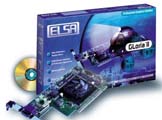 Video
Card – ELSA GLoria II (NVIDIA Quadro) - $650
Video
Card – ELSA GLoria II (NVIDIA Quadro) - $650
NVIDIA’s Quadro
is simply the most powerful workstation 3D accelerator we’ve tested to date.
Based on the same T&L GPU of the GeForce, the Quadro runs at a higher core
clock speed, 135 MHz, and enables certain features that were left disabled on
the GeForce. Among these features is enhanced support for anti-aliased points
and lines, which, although it isn’t a commonly used feature with most users,
was an extremely poor performance point for the GeForce.
With their previous experience in the professional market, ELSA was able to score exclusive rights to manufacture the Quadro. The GLoria II is ELSA’s implementation and comes with 64MB SDR SDRAM. While a DDR version of the Quadro has been announced, and even tested by AnandTech, it’s not actually available anywhere at the moment. At $650, the SDR version of the GLoria II is a relative steal compared to some of the other professional 3D accelerators out there. Throw in the fact that it’s fully support under Windows NT 4.0, Windows 2000, and Linux and it becomes quite clear that the Quadro is the best choice.
For more information, see our ELSA Gloria II Review.
 Monitor
– iiYama VisionMaster PRO 510 - $1000
Monitor
– iiYama VisionMaster PRO 510 - $1000
Using a Mitsubishi
Diamondtron NF, the iiYama VisionMaster Pro 510 provides a perfectly flat display
surface using the same technology in Sony’s FD Trinitron models, but at a lower
cost. Make sure you can deal with the damper wires that all Trinitron style
tubes have. The VisionMaster PRO 510 is a 22” monitor and has been highly acclaimed
here on AnandTech and by owners alike.
For more information, read our iiYama VisionMaster PRO 450 and VisionMaster PRO 510 Reviews.
Case – Supermicro SC750-A
Full Tower ATX - $150
We need a case
that can handle anything we can throw at it, but at a reasonable price level.
That case is the Supermicro SC750-A full tower and is available for about $150
with an Athlon approved 300W Sparkle power supply. A total of ten drive bays
and the ability to accept an extended ATX motherboard insures that this system
will always have room for upgrades.
For more information, read our Supermicro SC750-A Review.
 Sound
card – Sound Blaster Live! Value OEM - $50
Sound
card – Sound Blaster Live! Value OEM - $50
The choice here
is simple – SBLive!, since Creative is the only manufacturer offering complete
driver support under Windows 2000. If you want to save a bit more money, go
with any name brand card supported under Windows 2000.
Ethernet – Linksys EtherFast
10/100 - $20
We use Linksys
products here in the AnandTech lab all the time and have never been disappointed.
Besides, at just $20 for a card with full support directly from the manufacturer
under the major OS’s, including Linux and Windows 2000, the EtherFast 10/100
is a deal that’s impossible to pass up.
 Hard
drive – Maxtor Diamond Max 40 Plus 40GB - $300
Hard
drive – Maxtor Diamond Max 40 Plus 40GB - $300
We couldn’t get
a hold of one in time for our March 2000 Ultra ATA 66 Roundup, but the Diamond
Max 40 Plus is on the way to the lab now. Based on user feedback and reviews
around the web, this is clearly the fastest Ultra ATA 66 hard drive for now.
“For now” being the operative words, however, as the hard drive industry is
moving faster than ever before. For now, our high-end professional machine
will use the 40GB model from the Diamond Max 40 Plus family.
If you’re work is disk intensive, consider going with a 10,000 RPM drive and an Ultra 160 controller. The Atlas 10K II is widely available and is known to be one of the fastest drives available.
CD-ROM/CD-RW/DVD-ROM
Pioneer DVD-104S 10X Slot DVD - $140
Plextor Plexwriter 8/4/32 - $350
What high-end
system is complete today without a DVD-ROM? We decided to go with the Pioneer
DVD-104S, a 10X DVD-ROM drive with a slot-loading interface that is just too
slick. Of course, it also reads CDs as well at a swift 40X max clip.
If you don’t need DVD support, the Kenwood TrueX 72X will provide you with the fastest CD-ROM speed at a slightly lower cost of $120.
Plextor is back again, this time with the fastest IDE CD-R on the market right now. The PlexWriter 8/4/32 is their first entry into the IDE market, and it has been selling like hot cakes since its release.
 OS
– Windows 2000 Professional - $250
OS
– Windows 2000 Professional - $250
The choice here
is clear – Windows 2000 Professional is the latest and greatest OS from Microsoft
that provides all the functionality of NT 4.0, but enhanced hardware support.
If you want to stick with a more tried and true solution, go with NT 4.0 Workstation.
Value Professional
Once again, our
value system mirrors the high-end system with a bit of corner cutting. We still
needs lots of RAM, as much as our other high-end systems, in fact.
 Processor
– AMD Athlon 650 - $250
Processor
– AMD Athlon 650 - $250
The KX133 chipset
helps the AMD Athlon come close to a Pentium III clock for clock, but if you
compare dollar for dollar, the Athlon is the clear winner. The Athlon 650 is
the best bargain out there now on a performance/cost basis, so that’s our pick
for the value professional system. Throw in a Golden Fingers device and the
650 can easily overclock to somewhere between 700 and 800 MHz.
For more information on all Athlon processors, read our Athlon 1GHz Review.
Motherboard – EPoX EP-7KXA
- $140
If you’re going
with an Athlon CPU, the VIA KX133 chipset is clearly the best platform to run
it on. Unfortunately, there’s a lack of good KX133 boards that are also widely
available and that has driven price up considerably through good old supply
and demand. The EPoX is the only widely available KX133, so it’s our pick for
now, but better KX133 boards are on the way.
For more information, read our EPoX EP-7KXA Review.
Memory – 256MB Corsair
or Mushkin PC133 SDRAM (2x128MB DIMM’s) – $250
Once again, the
amount of memory is a key factor in overall system performance under professional
applications, so even our value system gets 256MB.
As for the exact brand of memory, we recommend Corsair or Mushkin modules. We use them in our test systems and have had absolutely no problems with them.
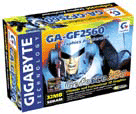 Video
card – Gigabyte GA-GF2560 SDR GeForce - $200
Video
card – Gigabyte GA-GF2560 SDR GeForce - $200
As long as you
don’t need support for anti-aliased lines, the GeForce keeps up with the Quadro
in most situations, but at less than one-third the cost. The key is the powerful
GPU that provides the most polygon power available today. This, of course,
makes the GeForce the perfect card for a value professional system. Fill rate
isn't as critical for professional applications, so SDR memory is sufficient.
We went with the Gigabyte as it was the winner of our GeForce SDR Roundup and it's reasonably priced. It's not the easiest SDR GeForce to find, but it is possible. If you can't find it, just go with the best deal on an SDR GeForce that you can find.
For more information, read our GeForce SDR Roundup and our Gigabyte GA-GF2570 Review.
 Monitor
– iiYama VisionMaster PRO 450 - $650
Monitor
– iiYama VisionMaster PRO 450 - $650
Using a Mitsubishi
Diamondtron NF, the iiYama VisionMaster Pro 450 provides a perfectly flat display
surface using the same technology in Sony’s FD Trinitron models, but at a lower
cost. Make sure you can deal with the damper wires that all Trinitron style
tubes have. The VisionMaster PRO 450 is a 19” monitor and it is highly recommended
here on AnandTech and by owners alike. If you’ve got the funds, we highly recommend
you go with the 22” VisionMaster PRO 510 for about $1000.
For more information, read our iiYama VisionMaster PRO 450 and VisionMaster PRO 510 Reviews.
Case – Supermicro SC750-A
Full Tower ATX - $150
We need a case
that can handle anything we can throw at it, but at a reasonable price level.
That case is the Supermicro SC750-A full tower and is available for about $150
with an Athlon approved 300W Sparkle power supply. A total of ten drive bays
and the ability to accept an extended ATX motherboard insures that this system
will always have room for upgrades.
For more information, read our Supermicro SC750-A Review.
 Sound
card – Sound Blaster Live! Value OEM - $50
Sound
card – Sound Blaster Live! Value OEM - $50
The choice here
is simple – SBLive!, since Creative is the only manufacturer offering complete
driver support under Windows 2000. If you want to save a bit more money, go
with any name brand card supported under Windows 2000.
Ethernet – Linksys EtherFast
10/100 - $20
We use Linksys
products here in the AnandTech lab all the time and have never been disappointed.
Besides, at just $20 for a card with full support directly from the manufacturer
under the major OS’s, including Linux and Windows 2000, the EtherFast 10/100
is a deal that’s impossible to pass up.
 Hard
drive – Maxtor Diamond Max 40 Plus 15GB - $160
Hard
drive – Maxtor Diamond Max 40 Plus 15GB - $160
We still maintain
that hard drive speed is one of the biggest bottlenecks in a system, so we won’t
skimp in this category. As such, we’ve simply chosen a smaller version of the
drive in our high-end system, the 15GB Maxtor Diamond Max 40 Plus. It provides
the same speed as the 40GB model, but with less storage space.
If you simply need more space, you can either drop down to a 5400rpm drive or pay a bit more for a larger 7200rpm model.
CD-ROM/CD-RW/DVD-ROM
- Name brand 40X – 50X CD-ROM - $40
While many will
suggest going with the cheapest CD-ROM you can find, we highly recommend that
you pick a name brand, not just the cheapest generic. Our experience with the
no-names is that many of them do not perform as advertised and even have trouble
reading less than perfect discs. Acer, Creative Labs, Toshiba, and Teac all
do an excellent job.
 OS
– Windows 2000 Professional - $250
OS
– Windows 2000 Professional - $250
The choice here
is clear – Windows 2000 Professional is the latest and greatest OS from Microsoft
that provides all the functionality of NT 4.0, but enhanced hardware support.
If you want to stick with a more tried and true solution, go with NT 4.0 Workstation.
Final Words
And so concludes the first edition of the AnandTech Buyer’s Guide. We intend to update the Buyer’s Guide on a regular basis, probably monthly if all goes as planned. As always, we’re open to feedback on the article. Remember that these are merely recommendations for a few system configurations. We know a lot of you won’t agree with the exact components chosen here, and we expect that, so plan on tweaking things a bit to get the perfect system for your needs. When sending in suggestions for, remember that all the components must be readily available in the market today in order to be considered for the Buyer’s Guide.







